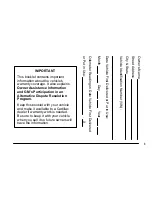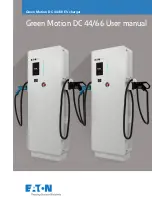
51
ROUTINE OPERATION
[WARNING]
To maintain control, combine downshifting, braking, and other
retarding devices. Downshifting to a lower transmission range increases
engine braking and helps maintain control. The transmission has a feature to
prevent automatic up shifting above the lower range selected. However, dur-
ing downhill operation, if the engine governed speed is exceeded in the lower
range, the transmission may upshift to the next higher range. This will reduce
braking. Apply the vehicle service brakes or other retarding device to prevent
exceeding engine governed speed in the lower range selected.
Transmission Indicators
Check Transmission Indicator
While driving, be alert to any abnormal shifting, unusual sounds or vibrations, smells,
or frequent illumination of a transmission priority message.
Transmission Oil Temperature
An oil temperature readout in the message display center on the instrument panel
indicates the transmission oil temperature. Extended operations at low vehicle
speeds with the engine at full throttle can cause excessive oil temperatures. These
temperatures may overheat the engine cooling system and lead to engine and/or
transmission damage.
If excessive temperature is indicated by the engine coolant temperature gauge,
stop the vehicle and check the cooling system. If the cooling system appears to be
functioning properly, shift to neutral and accelerate the engine to 1,200–1,500 rpm.
This will reduce the transmission temperature to operating level within two or three
minutes. If high temperature persists, stop the engine and have the overheating con-
dition investigated by service personnel.
If the transmission oil temperature readout indicates excessive temperature,
check the oil level in the transmission (refer to the Oil Check Procedure in your Allison
Transmission Operator’s Manual). Stop the vehicle and shift to neutral. Accelerate the
engine to 1,200–1,500 rpm. The temperature should return to normal within two or
three minutes before the vehicle resumes operation. Normal temperature for both
on and off-highway operation is 160° to 200° F. Oil temperature should never exceed
250° F. If the sump oil temperature reaches 250° F, the TCM will inhibit operation in
the higher gears and turn on a priority message in the message display center indi-
cating high transmission temperature.
If high temperature in either engine or transmission persists, stop the engine and
have the overheating conditions investigated by maintenance personnel.
[CAUTION]
The engine should never be operated for more than 30 seconds
at full throttle with the transmission in gear and the vehicle not moving.
Prolonged operation of this type will cause the transmission oil temperature
to become excessively high and will result in damage to the transmission.
Summary of Contents for Sigma Y3FE 2015
Page 1: ...COUNT ON BLUE BIRD 2015 D R I V E R S H A N D B O O K Y3FE BLUE BIRD SIGMA...
Page 2: ......
Page 3: ...10035741 Edition A Y3FE BLUE BIRD SIGMA C H A S S I S D R I V E R H A N D B O O K...
Page 6: ...4 DRIVER HANDBOOK Y3FE...
Page 25: ...23 ORIENTATION...
Page 28: ...26 DRIVER HANDBOOK Y3FE...
Page 36: ...34 DRIVER HANDBOOK Y3FE...
Page 43: ...41 ROUTINE OPERATION...
Page 69: ...67 CARE MAINTENANCE...
Page 78: ...DRIVER HANDBOOK Y3FE Notes 76...
Page 79: ...Notes 77...
Page 80: ...DRIVER HANDBOOK Y3FE Notes 78...
Page 81: ......
















































